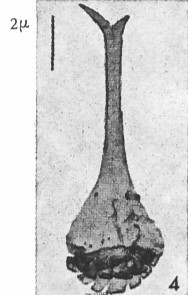Furcatolithus celsus
Set number: 840
-
1
-
2
-
3
-
4
10µm
Set number: 839
-
1
-
2
-
3
-
4
10µm
Sphenolithus celsus Haq, 1971
Furcatolith has a conical duolithic apical spine with or without distal bifurcation and a low cylindrical proximal cycle. The apical spine is triangular in the axial section.
In polarised light, the apical spine with axial c-axis shows maximum birefringence at 45° but extinct (dim) at 0° [the axial suture between the two helves is better seen at this orientation].
The diameter of the conical apical spine at its base is equal to the diameter of the cylindrical proximal cycle. The contact between the apical spine and the proximal cycle is flat.
Furcatolithus celsus differs from Furcatolithus distentus Martini,1965 and Furcatolithus ciperoensis (Bramlette & Wilcoxon 1967) Howe, 2021 by having a triangular apical spine whilst the latter species have kite shape apical spines in the axial section.
It is distinguished from Furcatolithus predistentus (Bramlette & Wilcoxon 1967) Howe, 2021 by having a diameter of the conical apical spine at its base is equal to the diameter of the proximal cycle. In the latter species, the diameter of the conical apical spine at its base is much greater than the diameter of the frustum shape proximal cycle. Moreover, Furcatolithus celsus lacks broadening at the base of its apical spine, characteristic of Furcatolithus predistentus.
This species was erroneously assigned to Sphenolithus predistentus.
Bramlette, M. N. & Wilcoxon, J. A. 1967. Middle Tertiary calcareous nannoplankton of the Cipero section, Trinidad, W.I. Tulane Studies in Geology and Paleontology 5: 93-131.
Haq, B. U. 1971. Paleogene calcareous nannoflora. Parts I-IV. Stockholm Contributions in Geology 25: 1-158.
Howe, R., 2021. Ultrastructure and taxonomy of the family Sphenolithaceae. Journal of Nannoplankton Research 39(1), 29-75.
Martini, E. 1965. Mid-Tertiary calcareous nannoplankton from Pacific deep-sea cores. Colston Papers 17: 393-411.
